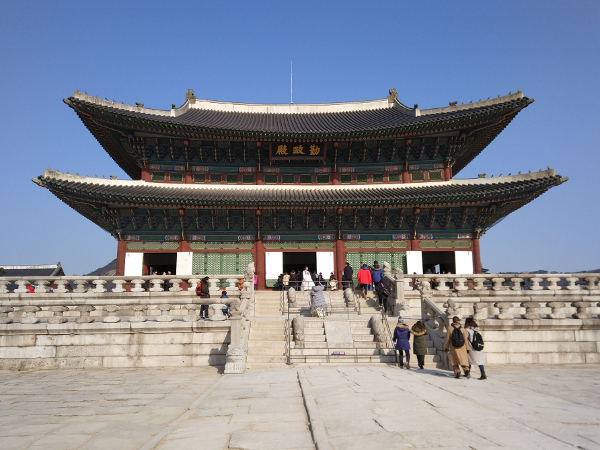Cours de coréen ᚛ Level 1 - My First Steps in Korean (Lessons 1 to 30) ᚛ Leçon 15 - Vowel Contractions in the Present Tense
Vowel Contractions in the Present Tense
Korean is a language that tends to simplify sentences or certain words in order to make expressions more fluid, which can happen when multiple vowel sounds follow each other.
When conjugating certain verbs in the present tense in Korean and when adding 아(요) or 어(요) after a stem that ends in a vowel, it is necessary to contract these vowels to simplify the verb structure.
The stem ends in ㅏ
ㅏ + 아 = ㅏ
가다 (= to go) has a stem 가 which ends in ㅏ. In theory, its casual present form should be 가아. However, ㅏ and 아 are contracted to ㅏ. So, 가다 is conjugated as 가 in the casual style and 가요 in the polite style.
The stem ends in ㅗ
ㅗ + 아 = ㅘ
보다 (= see) has a stem 보 which ends in ㅗ. In theory, its casual present form should be 보아. However, ㅗ and 아 are contracted to ㅘ. This means that 보다 is conjugated as 봐 in the casual style and 봐요 in the polite style.
Note: the contraction is not obligatory but extremely common, especially when speaking.
The stem ends in ㅓ
ㅓ + 어 = ㅓ
서다 (= to stop) has a stem 서 which ends in ㅓ. In theory, its casual present form should be 서어. However, ㅓ and 어 are contracted to ㅓ. This means that 서다 is conjugated as 서 in the casual style and 서요 in the polite style.
The stem ends in ㅜ
ㅜ + 어 = ㅝ
주다 (= to give) has a stem 주 which ends in ㅜ. In theory, its casual present form should be 주어. However, ㅜ and 어 are contracted to ㅝ. This means that 주다 is conjugated as 줘 in the casual style and 줘요 in the polite style.
Note: the contraction is not obligatory but extremely common, especially when speaking.
The stem ends in ㅣ
ㅣ + 어 = ㅕ
치다 (= to hit) has the stem 치 which ends in ㅣ. In theory, its casual present form should be 치어. However, ㅣ and 어 are contracted to ㅕ. This means that 치다 is conjugated as 쳐 in the casual style and 쳐요 in the polite style.
The stem ends in ㅐ
En savoir +
The stem ends in ㅔ
En savoir +
The stem ends in ㅚ
En savoir +
Summary table of structure
En savoir +
Exercises
En savoir +
Voyager en Corée du Sud peut être une expérience inoubliable. Mais quand on ne parle pas coréen, tout devient plus compliqué : commander au restaurant ou dans un café devient stressant ; on ne comprend aucun panneau ni enseigne ; en cas de souci, demander de l'aide est presque impossible ; et surtout, on manque l'essence même d'un voyage réussi en Corée : l'échange avec les locaux.
Comme les traducteurs automatiques français - coréen ne peuvent pas être fiables car les deux langues fonctionnent d'une manière totalement opposée, il devient alors crucial de se préparer soi-même pour profiter pleinement de son voyage en Corée du Sud.
Nous avons alors créé un guide conçu spécialement pour les voyageurs qui souhaitent profiter de la Corée sans galère linguistique !
En savoir +Commentaires (1)



